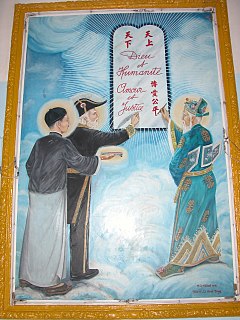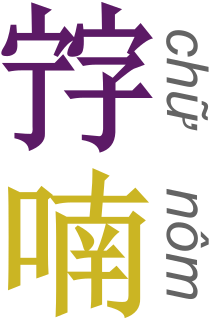Articles related to Vietnam and Vietnamese culture include:
The Vietnamese alphabet is the modern writing system for the Vietnamese language. It uses the Latin script, based on its employment in the alphabets of Romance languages, in particular the Portuguese alphabet, with some digraphs and the addition of nine accent marks or diacritics – four of them to create additional sounds, and the other five to indicate the tone of each word. The many diacritics, often two on the same vowel, make written Vietnamese easily recognizable.

Until the beginning of the 20th century, governmental and scholarly documents in Vietnam were written in classical Chinese, using Chinese characters with Vietnamese approximations of Middle Chinese pronunciations.

The Tày people speak a language of the Central Tai language group, and live in northern Vietnam. They are sometimes also called Thô, T'o, Tai Tho, Ngan, Phen, Thu Lao, or Pa Di.

Nguyễn Bỉnh Khiêm was a Vietnamese administrator, educator, poet, sage and later a saint of the Cao Dai religion. He is referred to by several names: tên huýNguyễn Văn Đạt, Hanh Phủ (亨甫), Bạch Vân cư sĩ and Trạng Trình.
The term Hòa Bình culture was first used by French archaeologists working in Northern Vietnam to describe Holocene period archaeological assemblages excavated from rock shelters. The related English adjective Hoabinhian has become a common term in the English-based literature to describe stone artifact assemblages in Southeast Asia that contain flaked, cobble artifacts, dated to c. 10,000–2000 BCE. The term was originally used to refer to a specific ethnic group, restricted to a limited period with a distinctive subsistence economy and technology. More recent work uses the term to refer to artifacts and assemblages with certain formal characteristics.
Vietnamese literature is the literature, both oral and written, created largely by Vietnamese-speaking people.

The Vietnamese Wikipedia is the Vietnamese-language edition of Wikipedia, a free, publicly editable, online encyclopedia supported by the Wikimedia Foundation. As with other language editions of Wikipedia, the project's content is both created and accessed using the MediaWiki wiki software. The Vietnamese Wikipedia's primary competitor is the Encyclopedic Dictionary of Vietnam, a state-funded encyclopedic dictionary also available online.

The Ba Vì mountain range is a soil-limestone mountain range in Vietnam. It covers an area of about 50 km2 in Ba Vì, Lương Sơn and Kỳ Sơn districts. The Ba Vì mountain range is called "the lord of mountains" in the Vietnamese spirit though it is not the highest mountain range in Vietnam.
Ngô Đức Kế (1878–1929) was a prominent scholar-gentry Vietnamese anti-colonial intellectual in the early 20th century. He was the publisher of an anti-French magazine in Hanoi and was sent to Côn Sơn Island, a prominent colonial jail for revolutionary dissidents.

The Con Moong cave is located in the Cúc Phương National Park, just south of Mọ village, in the Thanh Hóa Province, northern Vietnam. The Cúc Phương National Park administration not only manages a refuge for rare animals. The Department of Culture has also issued a certificate, that declares Con Moong prehistoric site and its surroundings as National Relics. Among these locations, the archaeological site of Con Moong cave is of central importance for the study of the Mesolithic Hoabinhian culture. In April and May 1976 Vietnamese archaeologists have excavated the site.

Dream memoir of Southern Man is a memoir written by Vietnamese official Hồ Nguyên Trừng during his exile in Ming dynasty in the early 15th century.

"Thanh Niên Hành Khúc", later known as "Call to the Citizens", Chữ Nôm: 㗂噲公民, and before that "March of the Students", Chữ Nôm: 生員行曲, was the national anthem of South Vietnam from 1948 to 1975.
Hồng Lĩnh is a mountain range in Hà Tĩnh Province and Nghệ An Province, Vietnam. Hồng Lĩnh is the tên chữ Sino-Vietnamese name ; the demotic tên nôm folk name is Rú Hống.

Phan Huy Ích was a Vietnamese poet. Phan Huy Ich served two dynasties, both the Le Dynasty then the Tay Son uprising. About the time of the collapse of the Tay Son dynasty he wrote the preface to Ngô Thì Nhậm's last book on Buddhism True Lam Tong Chi Nguyen Thanh. He was father of Phan Huy Chú (1782–1840) author of Lich Trieu Hien Chuong Loai Chi (1819).
The Institute of Hán-Nôm Studies, or Hán-Nôm Institute in Hanoi, Vietnam is the main research centre, historical archival agency and reference library for the study of chữ Hán and chữ Nôm texts in Vietnam. These are texts predating the adoption of the modern Latin-based Vietnamese alphabet.
Girolamo Maiorica was a 17th-century Italian Jesuit missionary to Vietnam. He is known for compiling numerous Roman Catholic works written in the Vietnamese language's demotic chữ Nôm script, both on his own and with assistance from local converts. Maiorica was one of the first authors of original Nôm prose. His works are seen as a milestone in the history of Vietnamese literature.

Chữ Nôm, in earlier times also called quốc âm or chữ nam, is a logographic writing system formerly used to write the Vietnamese language. It used the standard set of classical Chinese characters to represent Sino-Vietnamese vocabulary and some native Vietnamese words, while new characters were created on the Chinese model to represent other words.
The địa danh variant of a Vietnamese place is the official Chinese-character name historically used by the Sinophere's administration.

Đinh Bộ Lĩnh (924–979), originally named Đinh Hoàn (丁桓), was the first Vietnamese emperor following the liberation of the country from the rule of the Chinese Southern Han Dynasty, as well as the founder of the short-lived Đinh Dynasty and a significant figure in the establishment of Vietnamese independence and political unity in the 10th century. He unified Vietnam by defeating twelve rebellious warlords and became the first emperor of Vietnam. Upon his ascension, he renamed the country Đại Cồ Việt. Đinh Bộ Lĩnh is also known by his posthumous name Đinh Tiên Hoàng.












